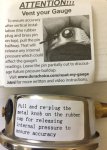The pressure gauge on my Pentair cartridge filter is starting to stick. So I bought a fancy new liquid-filled gauge from TFTestkits.
There are 2 conflicting instructions about venting the gauge. One says pull the plug and push it back in. The other says pull the plug halfway and leave it there. The URL on the paper insert does not exist.
Which is better? I should add the pin is really small, pops right out, and will be extremely easy to lose if it drops to the ground. So I'd prefer not touching it too often, but I'd worry having it halfway in would tempt it to pop out and disappear.

There are 2 conflicting instructions about venting the gauge. One says pull the plug and push it back in. The other says pull the plug halfway and leave it there. The URL on the paper insert does not exist.
Which is better? I should add the pin is really small, pops right out, and will be extremely easy to lose if it drops to the ground. So I'd prefer not touching it too often, but I'd worry having it halfway in would tempt it to pop out and disappear.


